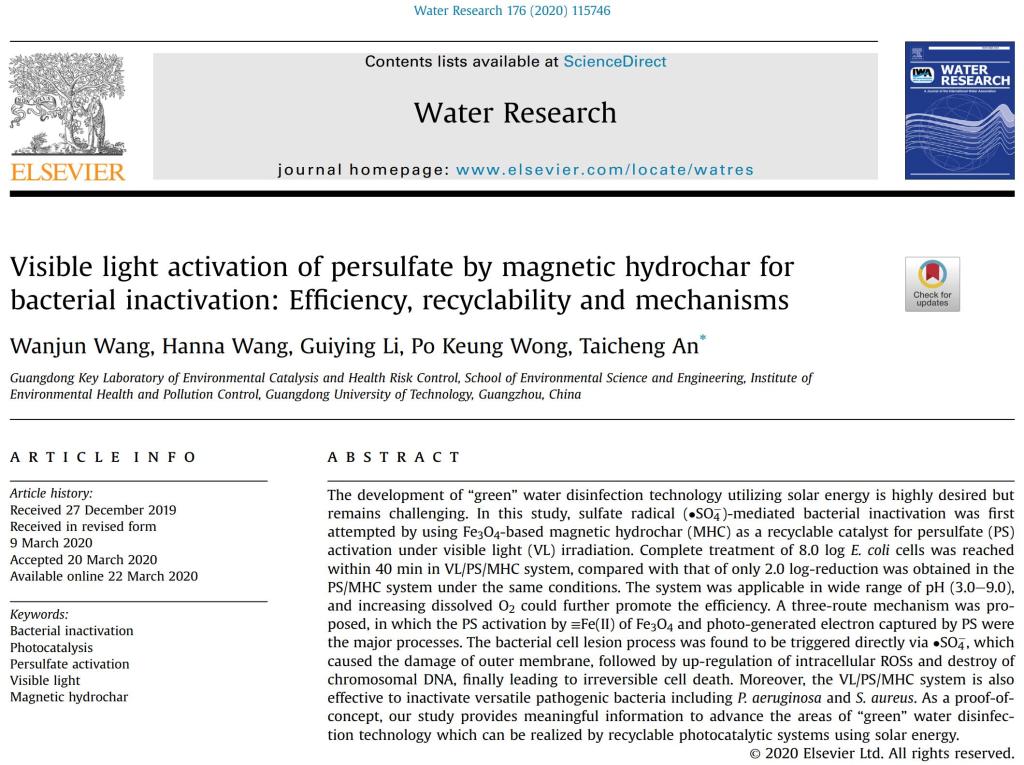近日,广东工业大学环境健康与污染控制研究院、环境科学与工程学院王万军教授和硕士生王韩纳等人在磁性水热炭杀灭病原微生物方面取得最新研究进展,研究成果以《Visible light activation of persulfate by magnetic hydrochar for bacterial inactivation: Efficiency, recyclability and mechanisms,2020, 115746》为题发表在国际水质学会会刊Water Research杂志上。该工作首次揭示了磁性水热炭能够在可见光下激活过硫酸盐实现杀灭细菌的应用,并且催化剂能够通过磁力回收再利用而不失活,系统阐明了过硫酸盐激活机制以及细菌在该体系中的灭活原理。

太阳能“绿色”消毒技术研发一直是国际关注的热点但极具挑战性。该论文首次尝试使用基于Fe3O4负载的磁性水热炭(MHC)作为可再循环的催化剂,在可见光(VL)照射下激活过硫酸盐(PS),从而实现硫酸根自由基(·SO4-)介导的细菌灭活。在该VL/PS/MHC体系中,40分钟内即可完全杀灭8.0 log浓度的大肠杆菌,而在相同条件下,PS/MHC体系仅能实现2.0 log细菌的杀灭,说明可见光照射起了决定性的作用。该体系可在pH=3.0-9.0的宽范围内均具有优异的细菌杀灭性能,并且增加溶解氧浓度可以进一步提高效率。机理研究证实PS激活存在三种途径,其中MHC表面≡Fe(II)的活化和PS直接捕获光生电子是主要过程。同时发现细菌细胞凋亡过程是直接通过•SO­4-引起的,这导致了细胞外膜的破坏、胞内ROS的上调和基因组DNA的破坏,最终造成不可逆的细胞死亡。此外,研究发现VL/PS/MHC系统还可以有效杀灭包括铜绿假单胞菌和金黄色葡萄球菌在内的多种致病细菌。该研究为推进利用太阳能的可回收光催化系统实现“绿色”消毒杀菌提供了新的思路和研究方向。
论文的网址:https://doi.org/10.1016/j.watres.2020.115746。
论文的英文摘要附如下:
ABSTRACT
The development of “green” water disinfection technology utilizing solar energy is highly desired but remains challenging. In this study, sulfate radical (•SO­4−)-mediated bacterial inactivation was first attempted by using Fe3O4-based magnetic hydrochar (MHC) as a recyclable catalyst for persulfate (PS) activation under visible light (VL) irradiation. Complete treatment of 8.0 log E. coli cells was reached within 40 min in VL/PS/MHC system, compared with that of only 2.0 log-reduction was obtained in the PS/MHC system under the same conditions. The system was applicable in wide range of pH (3.0–9.0), and increasing dissolved O2 could further promote the efficiency. A three-route mechanism was proposed, in which the PS activation by ≡Fe(II) of Fe3O4 and photo-generated electron captured by PS were the major processes. The bacterial cell lesion process was found to be triggered directly via •SO4−, which caused the damage of outer membrane, followed by up-regulation of intracellular ROSs and destroy of chromosomal DNA, finally leading to irreversible cell death. Moreover, the VL/PS/MHC system is also effective to inactivate versatile pathogenic bacteria including P. aeruginosa and S. aureus. As a proof-of-concept, our study provides meaningful information to advance the areas of “green” water disinfection technology which can be realized by recyclable photocatalytic systems using solar energy.